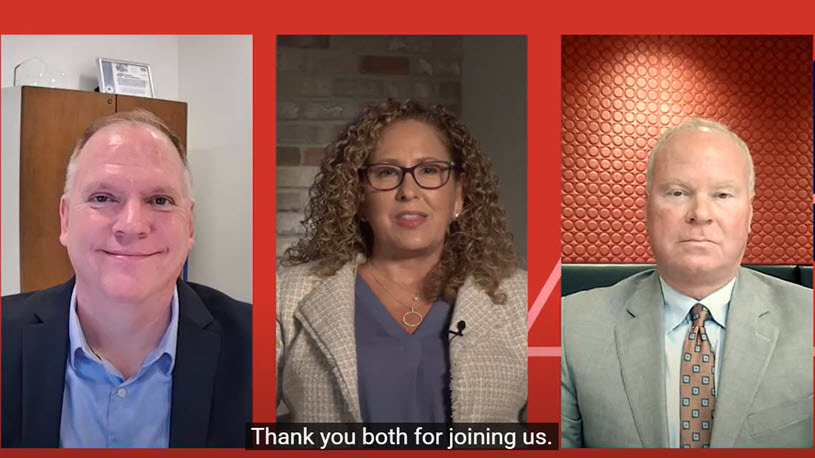Tax Credits and Tax-Favored Savings: Implications of the One Big Beautiful Bill Act
Part of a series | The One Big Beautiful Bill Act Series

H.R.1, known as the One Big Beautiful Bill Act, has tax provisions that may impact organizations and their employees next tax season. In this video, ADP subject matter experts, Meg Ferrero, vice president, assistant general counsel; Ron Ulrich, vice president, product consulting and compliance; and Michael Smith, director of tax strategic partnerships, highlight key changes in the bill and share tips on how employers can prepare.
For more information on the H.R.1, One Big Beautiful Bill Act, visit the ADP resource hub page at ADP.com/BigBeautifulBill.
Video transcript:
Meg Ferrero: Businesses and workers are talking about H.R.1 and how it will impact them. H.R.1 is also known as the One Big Beautiful Bill Act, and it has many provisions that will impact organizations and their employees. To talk about some of those new tax implications of the law. I'm joined by Ron Ulrich, vice president, product consulting and compliance, and Michael Smith, director of tax strategic partnerships. Thank you both for joining us. So, Michael, let's start with you from a business perspective. What parts of the law are you watching?
How does the One Big Beautiful Bill Act impact research and development (R&D) tax credits and deductions?
Michael Smith: I'm looking at the research and development expenses. There's been no change to the actual program as it relates to the criteria for qualifications. However, under the old law, there was this requirement for amortizing those expenses, perhaps over five years if in the US or over 15 years outside the US. The new law provides some relief in order.
We can go back to the actual immediate expensing of R&D costs, particularly if they're in the U.S. if they're outside the U.S. There's still that caveat that they must be amortized over a 15-year period. Additionally, and importantly to note, is that, for the year 2021 through 2024, small businesses and small businesses are defined as 31 million or less in gross receipts.
They can go back and amend the returns and do the immediate expensing for larger businesses. They may be able to take the credit or the remaining deductions over a two-year period.
What do employers need to know about the Trump savings accounts created by the One Big Beautiful Bill Act?
Meg: Okay. Ron, I want to turn to you next from an employee point of view. One of the provisions of the bill impacts workers with children. What do we know so far about these accounts?
Ron Ulrich: Yes, those are Trump accounts. So, they're a new tax-favored savings account for individuals under the age of 18. And parents can set up these accounts for their children. And they can contribute up to $5,000 per year as an after-tax contribution. Other friends and relatives can even contribute to these accounts, as can employers. Employers can contribute up to $2,500 a year into a Trump account. That amount must be under the $5,000 limit with all the other contributions combined. But another interesting twist to this is that nonprofits and even governments can make contributions to these accounts on behalf of children.
Contributions can only be made up until the year the child turns 18, and they must stop. Once the child turns 18, they can start taking withdrawals. No withdrawals can occur before the age of 18. At that time, it appears that these accounts turn into pretty much regular traditional IRA accounts in terms of contributions and distributions going forward. These accounts must be invested in low-cost mutual funds or exchange-traded funds that track a US stock index like the S&P 500, for example.
There are many details that will need to be worked out about these accounts. And we expect the Treasury Department and the IRS to provide guidance on how to properly account for and report on these accounts. Finally, the act includes a temporary newborn pilot program that will allow the government to contribute $1,000 for every child born after 2024 and before 2029 to really kickstart these accounts them.
What do employers need to know about the paid family and medical leave tax credit and the employer-paid childcare credit from the One Big Beautiful Bill Act?
Meg: Thanks, Ron. Similarly, we're waiting for guidance from the IRS and the Treasury on the overtime and tip deductions as well. Michael, what other credits are available to businesses for them to assist their employees?
Michael: There are two other credits that we are watching very closely that are of significance. I'll first start with the paid family and medical leave tax credit. The good news is that this has been made permanent. Additionally, there is now a six-month requirement for tenure. And in addition to the fact that employees need to work on average 20 hours per week. Employees can claim the credit for a percentage of the premiums paid or wages paid during the employee's leave.
Additionally, the other one I want to bring to everyone's attention is the employer-paid childcare credit. That credit cap has been raised significantly from 150,000 to 500,000. Additionally, the rate has been raised from 25% to 40% of the eligible cost. Small businesses benefit further in terms of up to $600,000 cap at a 50% rate of qualifying costs. Additionally, the new bill provides flexibility in terms of pooling and third-party intermediaries.
How can employers stay informed about and comply with provisions in the One Big Beautiful Bill Act?
Meg: Thanks, Michael. With so much guidance forthcoming. Ron, I wanted to ask you, what's the best way for organizations to stay informed?
Ron: Yeah, it's going to be tough. H.R.1 is a very expansive bill. It contains a lot of provisions that will become effective over the next year or so, with some provisions even retroactively effective. So, it will be important to stay up to date on the latest guidance.
Employers can look to their trusted advisor, whether that's a financial advisor or CPA or even industry groups that they are a part of. And, of course, ADP will continue to provide updates as they become available. So, we encourage everyone to take advantage of all the resources at their disposal to stay up to date.
ADP maintains updated information on the H.R.1, One Big Beautiful Bill Act, on our resource hub page at ADP.com/BigBeautifulBill.
Meg: Thanks, Ron. Thanks, Michael. We appreciate all your insights.



